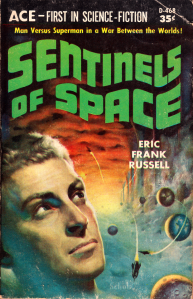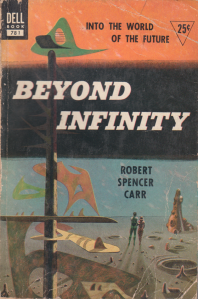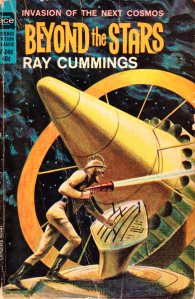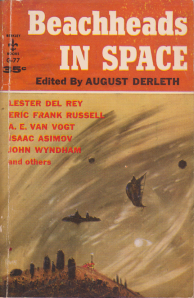The Book: The Outer Reaches: Favorite Science-Fiction Tales Chosen by their Authors edited by August Derleth. Originally published in 1951. The paperback edition contains 10 of the 17 stories from the hardback edition. Published by Berkley Books, G-116.

The Stories:
“Co-Operate—or Else!” – A. E. van Vogt, 1942 – A man and his mortal enemy, a super-intelligent, telepathic, space panther, must survive on an extremely hostile planet.
“Good Night, Mr. James” – Clifford D. Simak, 1951 – A clever little story about a scientist who made a mistake and now must remedy it. Much fun.
“The Critters” – Frank Belknap Long, 1945 – An old man lives high up in the hills, away from an alien invasion. Didn’t care for this one.
“Death Sentence” – Isaac Asimov, 1943 – The government takes over the operations of a rogue archaeologist who has discovered an ancient civilization of robots-who-don’t-know-they’re-robots.
“This Is the Land” – Nelson S. Bond, 1951 – The children of the last survivor of a nuclear holocaust bury him on the surface.
“Ylla” – Ray Bradbury, 1950 – From The Martian Chronicles. I skipped it here.
“The Green Cat” – Cleve Cartmill, 1951 – No one questions that there’s anything weird about a green cat with leaf-shaped ears.
“Pardon My Mistake” – Fletcher Pratt, 1946 – A man, mad with jealousy, makes a mistake.
“The Plutonian Drug” – Clark Ashton Smith, 1934 – Space travel leads to new medicines and drugs, including one that might just let you see into the future…
“Farewell to Eden” – Theodore Sturgeon, 1949 – A man and a woman, awakened from a long cryo-sleep, leave a bomb ravaged earth for a better home.
The Evaluation: These stories are all pretty good. And, if not, they’re pretty short. The idea of authors choosing a favorite tale is quite nice. “Good Night, Mr. James” is my favorite of the group as it hits a nice balance of clever, pacing, and length.
The Cover: No credit for the cover art. Sadly, the scene on the cover isn’t from any of the stories, but it is a fine science fiction scene. Though, I have to say, is seems a bit dangerous to have pick axes in a low atmosphere environment.
Next Up: The Weapon Shops of Isher by A.E. Van Vogt.
 Nightchaser by Amanda Bouchet
Nightchaser by Amanda Bouchet







